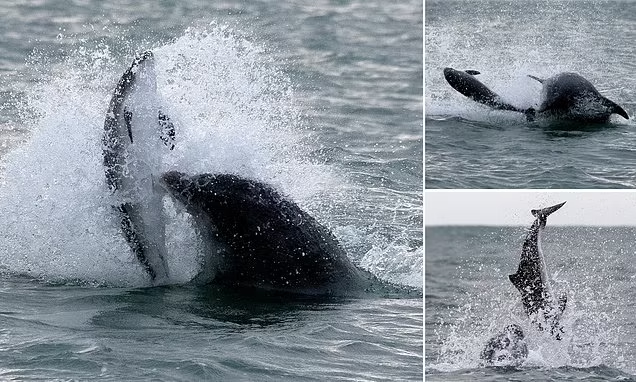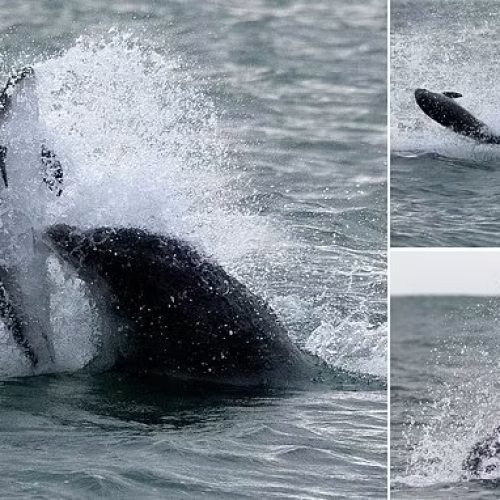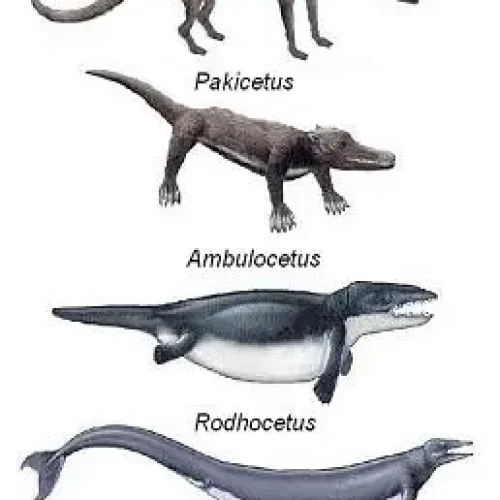In this article
THE REMARKABLE ANATOMY OF THE DOLPHIN’S ‘BEAK’
The dolphin’s rostrum is a testament to nature’s ingenuity.
This elongated portion of the skull houses a complex network of tissues, nerves, and specialized structures that work in harmony to give dolphins their exceptional sensing abilities.
Key components of the rostrum include:
• Dense, elongated jawbones
• Highly innervated tissue
• Specialized fat deposits
• An intricate network of air sacs
These elements combine to create a biological sonar system that puts human technology to shame.
The rostrum’s shape and composition allow dolphins to produce and receive high-frequency sound waves, enabling them to navigate, communicate, and hunt with remarkable precision.
Structure and composition of the dolphin rostrum
The dolphin’s rostrum is a masterpiece of biological engineering. Its streamlined shape cuts through water effortlessly, while its internal structure is optimized for sound production and reception.
The lower jaw contains a fatty structure called the ‘melon’, which focuses outgoing sound waves. Meanwhile, the upper jaw houses sensitive receptors that detect returning echoes.
This arrangement allows dolphins to build detailed ‘sound pictures’ of their surroundings, even in murky waters or total darkness.

Differences between dolphin species’ beaks
While all dolphins share the basic rostrum structure, there’s considerable variation among species. These differences reflect adaptations to specific habitats and feeding strategies:
• Bottlenose dolphins: Medium-length, sturdy beaks suited for catching a variety of prey
• Amazon river dolphins: Long, slender beaks for probing river bottoms and catching small fish
• Risso’s dolphins: Shorter, blunter beaks adapted for catching squid in deep waters
These variations showcase the rostrum’s versatility as an evolutionary adaptation.
Evolution of the dolphin’s distinctive snout
The dolphin’s rostrum is a product of millions of years of evolution.
Early whale ancestors had more traditional mammalian snouts, but as they adapted to aquatic life, their facial structure underwent dramatic changes.
Over time, the snout elongated and streamlined, while internal structures evolved to support echolocation.
This gradual transformation turned the simple mammalian nose into the sophisticated sensing organ we see in modern dolphins.
The rostrum’s evolution highlights nature’s ability to repurpose existing structures for new functions.
What began as a simple breathing and feeding apparatus became a highly specialized tool for underwater perception.
In the vast, often murky expanses of the world’s oceans, the dolphin’s ‘beak’ stands as a testament to the power of evolutionary adaptation.
This remarkable structure allows these intelligent marine mammals to thrive in their aquatic realm, navigating, communicating, and hunting with a precision that continues to amaze scientists and nature enthusiasts alike.
ECHOLOCATION: THE DOLPHIN’S SIXTH SENSE
Echolocation, often called nature’s sonar, allows these marine mammals to navigate, hunt, and communicate with astonishing precision in the murky depths of the ocean.
How dolphins produce and receive sound waves
Dolphins are vocal virtuosos, producing a wide range of clicks, whistles, and pulsed sounds. These vocalizations originate in the nasal passages, not the mouth as one might expect.
The process begins when air is pushed through a structure called the phonic lips, creating high-frequency clicks that can reach up to 150 kilohertz – well beyond human hearing range.
The dolphin’s uniquely shaped lower jaw acts as a highly sensitive receiver for these sound waves. Filled with a specialized fat that conducts sound efficiently, the jaw channels incoming echoes directly to the middle ear.
This anatomical setup allows dolphins to pinpoint the location of objects with remarkable accuracy, sometimes detecting a small fish from over 70 meters away.
Role of the melon in focusing sound beams
Atop a dolphin’s head sits the melon – a rounded, fatty organ that plays a crucial role in echolocation. This biological sound lens focuses outgoing clicks into a narrow, directional beam.
By adjusting the shape and density of the melon, dolphins can fine-tune their sonar, much like adjusting the focus on a camera lens.
The melon’s composition is fascinating: it consists of specialized fatty tissues arranged in concentric layers.
This structure allows sound waves to travel at different speeds through the organ, effectively creating an acoustic lens that can be dynamically adjusted based on the dolphin’s needs.
Processing of acoustic information in the dolphin brain
The true magic of echolocation happens in the dolphin’s brain. As echoes bounce back from objects in the environment, they’re rapidly processed to create a detailed 3D “sound picture” of the surroundings.
This acoustic image provides information about an object’s size, shape, texture, and even internal structure.
Dolphins dedicate a significant portion of their brain to auditory processing. Advanced imaging studies have revealed that their auditory cortex is highly developed and intricately connected to other brain regions.
This neural architecture allows for lightning-fast analysis of complex acoustic information, enabling dolphins to make split-second decisions while hunting or navigating.
• Dolphins can distinguish between objects as small as 2.5 centimeters in size.
• They’re capable of detecting differences in material density as slight as 5%.
• Some species can echolocate effectively even in noisy, shallow waters.
The precision of dolphin echolocation has inspired human innovations.
Biomimetic sonar systems, modeled after dolphin biosonar, are being developed for underwater exploration, marine mammal research, and even medical imaging applications.
As we continue to unravel the mysteries of dolphin echolocation, one thing becomes clear: these marine mammals possess a sensory superpower that has evolved over millions of years to perfection.
Their ability to “see” with sound not only ensures their survival in the ocean’s challenging environment but also serves as a testament to nature’s ingenuity.
BEYOND ECHOLOCATION: OTHER FUNCTIONS OF THE DOLPHIN’S BEAK
While the dolphin’s rostrum is renowned for its echolocation capabilities, this remarkable structure serves multiple purposes beyond navigation.
The versatile ‘beak’ plays crucial roles in feeding, social interactions, and even defense.
Let’s dive deeper into these lesser-known functions that make the dolphin’s snout a true multi-tool of the sea.
Feeding and prey manipulation
The dolphin’s beak is an essential instrument for catching and handling prey. Its elongated shape allows for quick, precise movements in the water, enabling dolphins to snatch fast-moving fish with remarkable accuracy.
The rostrum’s structure varies among species, reflecting different feeding strategies:
• Bottlenose dolphins use their sturdy beaks to grab and crush fish, sometimes even using them to dig in the seabed for hidden prey.
• River dolphins, with their long, slender snouts, can probe into crevices and muddy bottoms to find elusive fish.
• Some species, like the rough-toothed dolphin, have ridges on their beaks that help them grip slippery prey.
The beak’s sensitivity also plays a role in feeding. Dolphins can detect the electrical fields generated by fish, helping them locate prey even when visibility is poor.
This combination of form and function makes the rostrum an incredibly efficient feeding tool.
Social interactions and communication
Dolphins are highly social creatures, and their beaks play a significant role in their complex social lives.
While vocalizations are a primary mode of dolphin communication, physical contact via the rostrum is also important:
• Gentle nudges with the beak can serve as greetings or expressions of affection between pod members.
• During courtship, male dolphins may caress females with their rostrums as part of elaborate mating rituals.
• Mother dolphins often guide their calves by gently pushing them with their beaks.
The rostrum’s role in social bonding extends beyond touch.
Some scientists believe that dolphins can recognize individual pod members by the unique echo signature of their beaks, adding another layer to their social recognition capabilities.
Defense and object manipulation
While dolphins are generally peaceful creatures, their beaks can serve as formidable weapons when needed. In confrontations with predators or during disputes with other dolphins, a quick, forceful jab with the rostrum can deliver a powerful blow.
Beyond defense, dolphins showcase remarkable dexterity with their beaks:
• They can use their rostrums to carry objects, such as seaweed or small rocks, sometimes as part of play behaviors.
• Some dolphins have been observed using sponges held in their beaks as tools to protect their snouts while foraging on the seabed.
• The beak’s sensitivity allows dolphins to explore and interact with their environment, much like humans use their hands.
This object manipulation demonstrates the dolphin’s intelligence and adaptability, with the rostrum serving as a vital interface between the animal and its surroundings.
From a specialized feeding apparatus to a social tool and even a means of defense, the rostrum exemplifies how a single anatomical feature can serve multiple complex functions.
This versatility has undoubtedly contributed to the dolphin’s success as one of the ocean’s most adaptable and intelligent inhabitants.








